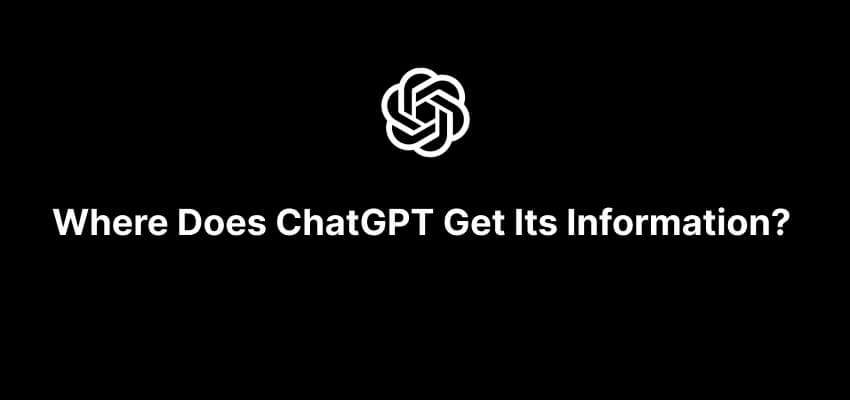Where Does ChatGPT Get Its Information?
ChatGPT is an OpenAI language model that can provide human-like replies to natural language questions. Its goal is to give consumers accurate and relevant information by analysing and comprehending data gathered from diverse sources. So where does ChatGPT get its information, and how does it verify its data’s integrity and dependability?
In this post, we’ll look at the sources of information for ChatGPT, the relevance of data quality, ChatGPT’s usage of AI and machine learning, and the ethical aspects involved in information collection and use.
Sources of Information for ChatGPT
Web Crawling
Web crawling is a major source of information for ChatGPT. ChatGPT extracts information from a variety of internet sources, including blogs, news stories, research papers, and other online resources, using web crawlers. Crawlers work by following links and indexing the material on each page. This enables ChatGPT to collect a vast quantity of data on a wide range of topics, which it may subsequently utilise to provide replies to user questions.
Databases
ChatGPT retrieves and collects information from huge databases such as Wikipedia, OpenAI’s knowledge base, and other authoritative sources of information. These databases include a wide range of data on a variety of topics, making them an invaluable resource for ChatGPT. ChatGPT can guarantee that the information it gives is correct and up to date by accessing various databases.
User Input
Users can also give ChatGPT feedback by asking questions or expressing remarks. This information can be utilised to improve the accuracy and relevancy of ChatGPT’s information. For example, if a user asks a question that ChatGPT is unable to answer, the programme may utilise this information to enhance its understanding of the topic and provide a more correct response in the future.
The Importance of Data Quality
Data accuracy is essential to ChatGPT’s capacity to provide users with accurate and relevant information. If the information provided by ChatGPT is incorrect or unethical, users may lose trust in it and be less likely to use it in the future. ChatGPT uses a variety of quality control techniques to verify the accuracy and reliability of the information it delivers, including:
- Data Filtering: ChatGPT excludes irrelevant or spammy content by analysing the text and metadata of the data it collects. This ensures that only high-quality data is utilised to create replies.
- Data Verification: ChatGPT confirms the information it collects by cross-referencing it with other sources and looking for consistency. This contributes to the information’s dependability and accuracy.
- Data Cleaning: ChatGPT cleans and evaluates the information it collects in order to remove any mistakes or inconsistencies. This helps to guarantee that the data is consistent and correct.
ChatGPT’s Use of AI and Machine Learning
ChatGPT studies and understands the data it collects using AI and machine learning. This enables it to detect patterns and links between various types of data, which it may then utilise to create more accurate and relevant replies to user queries. ChatGPT may also improve over time by learning from its interactions with users due to machine learning. ChatGPT can better satisfy the demands of its users by evaluating the input it gets.
Ethical Considerations
The collection and use of information for ChatGPT pose ethical concerns that must be solved. Among these factors are:
- Privacy: ChatGPT respect and protect users’ privacy by safeguarding their personal information and not giving it to other parties without their permission.
- Bias: ChatGPT must also be aware of the possibility of bias in the data it collects and the replies it creates. This can be due to various reasons, including the information sources used, the algorithms used to evaluate the data, and the preferences of the engineers who developed ChatGPT. To overcome this issue, ChatGPT’s developers must take efforts to reduce bias and maintain the system’s integrity and reliability.
- Transparency: ChatGPT must be open about the information sources it uses and the techniques it uses to evaluate and understand the data. This helps build trust with users and ensures that they know how the system operates.
- Responsibility: The developers of ChatGPT are responsible for ensuring that the system functions with integrity and responsibly. This involves being transparent about the system’s limits, giving users clear and accurate information, and taking steps to fix any faults or errors.
Conclusion
In conclusion, ChatGPT gathers information from a number of sources, including web crawling, databases, and user input. Quality control processes such as data filtering, verification, and cleaning assure the correctness and dependability of this information. ChatGPT also uses AI and machine learning to study and understand the data it collects, allowing it to respond to user queries with more accuracy and relevance. However, while gathering and using this information, ethical factors such as privacy, bias, transparency, and responsibility must be considered. By fixing these concerns, ChatGPT will be able to continue to give relevant and reliable info to users while following ethical standards.


